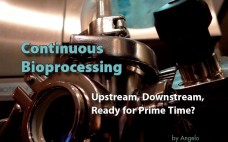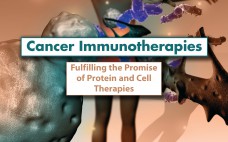In the early 2000s, the trade press was abuzz about an imminent “capacity crunch” in mammalian cell culture. Dire predictions of shortages were based on biopharmaceutical successes to that point, on bursting development pipelines, and on the lengthy timelines and high costs of assembling tens of thousands of liters of stainless-steel bioreactors and supporting infrastructure. Those predictions failed to anticipate several positive developments that would render doom-and-gloom scenarios moot. Notably, yearly improvements in protein titers for MAb processes already were…
Author Archives: Angelo DePalma
eBook: Making Filtration Work
Steady improvements in batch-fed cell culture have led to bottlenecks in downstream processing. Filter suppliers are working to improve available tools for purifying therapeutic proteins, to wring every possible efficiency out of those tools, and to make them operate together harmoniously. The combination of high titers and high-value products places a premium on preventing yield loss. Bioprocessors want to optimize filtration primarily for cost reasons. In this eBook, author Angelo DePalma discusses financial aspects, clarification/harvest and virus filtration options, and…
eBook: Alternative Delivery of Biologics — Underdogs Pursue Roads Less Traveled
A number of failures in development of noninjectable delivery methods for therapeutic proteins have caused numerous development programs to crash and burn along with investors’ hopes, dreams, and cash. Most everyone reading BioProcess International is familiar with the issues and challenges: Needles hurt and involve risks to both caregivers and patients. Injections often require administration by trained personnel in specialized settings. But alternative delivery methods are fraught with greater challenges related to dosing, bioavailability (particularly for oral dosing), and inherent…
Postapproval CMC Changes: Increasingly a Fact of Biopharmaceutical Life
The manufacture of vaccines and therapeutic proteins has suffered from a reputation of being part art and part science, with heavy doses of regulatory uncertainty thrown in. Postapproval changes (PACs) to chemistry, manufacturing, and controls (CMC) were initiated reluctantly and carefully in the era of “the process is the product.” Today, CMC PACs are a normal part of the biopharmaceutical industry business. Emma Ramnarine (head of global biologics quality control at Hoffmann-La Roche in South San Francisco, CA) notes that…
Extractables and Leachables: Standardizing Approaches to Manage the Risk
The implementation, maturation, and benefits of single-use technologies in biopharmaceutical development and manufacturing are well documented and understood. As analytical methods and testing services also rapidly improve, it is clear that management of risk associated with extractables and leachables also must evolve. Standardization is universally accepted as a goal; how to define, implement, and educate the industry is where debate resides. The container–closure segment has had more experience dealing with leachables and extractables than those implementing single-use process components do…
Biopharmaceutical Fill and Finish: Technical and Operating Challenges for the Latest Formulations and Devices
Because they occur after two highly engineering, and science-driven phases of biomanufacturing – expression and purification – biopharmaceutical fill and finish processes have not received the respect traditionally that they deserve. Yet of all competencies associated with bringing biopharmaceuticals to market, fill and finish arguably are the most specialized. This eBook reports on the technical and operating challenges impacting the latest formulations and devices including: outsourcing, contamination, standardization (pre-filled syringes), lyophilization, and serialization. Get informed on the current state-of-the-art technologies…
Special Report on Antibody-Drug Conjugates: Technical Challenges and Opportunities
Among the emerging targeted therapies in biotechnology, antibody–drug conjugates (ADCs) hold a unique position. An ADC consists of a monoclonal antibody (MAb) with affinity to tumor cells, a cytotoxic small-molecule payload, and a linker connecting the two. Together the MAb, conjugation chemistry, and cytotoxin increase the complexity of ADCs several-fold relative to unmodified MAbs — and exponentially relative to chemotherapies. Viewing ADCs as hybrids of antibody- and chemotherapy-based cancer therapies is tempting. That description applies chemically and structurally, but ADCs’…
Special Report on Continuous Bioprocessing: Upstream, Downstream, Ready for Prime Time?
Once an engineering curiosity and smallscale laboratory technique, continuous bioprocessing has evolved in just a few short years to a topic of intense and increasing interest to most bioprocessors. Critics point to a steep learning/adoption curve, but that is nothing new in biomanufacturing.Andrew Zydney is a distinguished professor of chemical engineering at Pennsylvania State University. He has noted these challenges facing continuous processing: commercially unproven unit operations (especially downstream), a lack of equipment robustness, sterility concerns, and uncertain development timelines…
Cancer Immunotherapies: Fulfilling the Promise of Protein and Cell Therapies
With few exceptions, both small-molecule and biological cancer treatments have contributed only incrementally towards achieving long-term responses or outright cures. In this regard, emerging cell- and protein-based cancer immunotherapies represent game-changing strategies for treating even refractory cancer. With long-term responses now possible, medical science may be on the verge of delivering on the long-unfulfilled promise of making cancer a manageable disease. But impediments to commercializing cancer immunotherapies are substantial. Producing cell-based treatments entails substantial hands-on manipulation and perfecting the logistics…
Special Report: Turning Discoveries into Products — Developability Assessments and Highly Efficient Process Design
High costs and long timelines for biopharmaceutical development are cause for reflecting on how best to allocate resources from the earliest discovery stage through critical go–no-go junctures. With inputs ranging from science, engineering, and economics, the coined term developability becomes the synthesis of answers to such questions as How well does the target represent a disease state? Does manipulating that state bring about improvement? Does the molecule behave as expected in living systems? What can be done about the emergence of independent safety, toxicology, and/or immunogenicity warning signs? Can the molecule…










